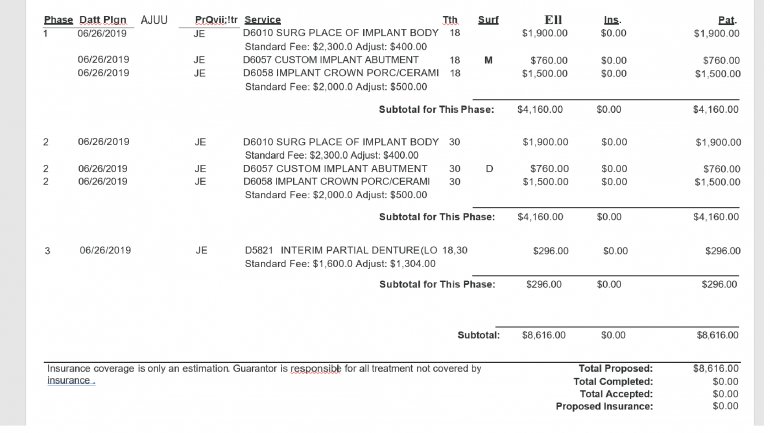
Dental Code D1352: Preventive resin restoration in a moderate to high caries risk patient – permanent tooth
Dental Code D1352 refers to the procedure known as preventive resin restoration in a moderate to high caries risk patient, specifically for permanent teeth. This dental code is used to describe a specific treatment approach aimed at preventing further decay and preserving the tooth structure.
On average, patients pay $120 for this D1352 service at the dentist's office, with as little as $50 charged for this in less expensive cities and as much as $180 in more expensive cities.
Low cost of living | Medium cost of living | High cost of living |
Memphis (Tennessee), Cincinnati (Ohio) | Miami (Florida), Denver (Colorado), Austin (Texas) | (New York (New York), San Francisco (California) |
$50 | $120 | $180 |
However, the price for the service D1352 depends not only on the region where you live, but also varies from dentist to dentist. Therefore, it makes sense to compare prices before choosing a dentist. The best way to do this price comparison is at Dr. BestPrice and save a lot of money.
What does Dental Code D1352 mean?
Dental Code D1352, also known as preventive resin restoration, is a dental procedure that aims to prevent the progression of dental caries (tooth decay) in patients with a moderate to high risk of developing cavities. The treatment involves the application of a resin-based material to the tooth surface to seal and protect it from decay-causing bacteria and acids.
Examination and Assessment
The first step in the preventive resin restoration procedure is a comprehensive examination by the dentist. During this examination, the dentist will evaluate the patient's dental history, risk factors for caries, and conduct a thorough examination of the teeth. Risk factors may include poor oral hygiene, a high sugar diet, previous dental restorations, dry mouth, or certain medical conditions. This assessment helps determine the suitability of the patient for the procedure and identifies the teeth that require treatment.
Cleaning and Preparation
Before the resin restoration, the tooth surface is cleaned and prepared. The dentist will remove any plaque, tartar, or decayed tooth structure using specialized dental instruments. This process, known as dental prophylaxis, ensures a clean and stable surface for the resin material to adhere to. Removing the decayed tooth structure is essential to prevent further progression of the caries.
Isolation and Etching
To ensure optimal bonding of the resin material, the tooth is isolated from saliva and moisture. The dentist may place a rubber dam, which is a thin sheet of rubber, or use cotton rolls to keep the area dry. By isolating the tooth, the dentist can achieve better control over the bonding process.
Next, a mild acid solution, known as an etchant, is applied to the tooth surface. The etchant is usually made of phosphoric acid and creates microscopic pores in the enamel. These pores enhance the bond between the resin material and the tooth. The etchant is applied for a short period and then rinsed off thoroughly.
Application of Resin Material
Once the tooth is prepared, the dentist applies the resin material. The material used is a composite resin, which is a mixture of plastic and glass particles. Composite resins are tooth-colored and can be matched closely to the natural shade of the patient's teeth, providing a more aesthetically pleasing result.
The dentist carefully molds and shapes the resin to restore the natural contours of the tooth. Multiple layers of the resin may be applied, with each layer being hardened using a special curing light. The curing light emits a specific wavelength of light that activates the resin, causing it to harden and adhere firmly to the tooth surface.
Finishing and Polishing
After the resin material has hardened, the dentist trims and shapes it to achieve the desired shape and bite. This step ensures that the restored tooth is aligned properly with the adjacent teeth and does not interfere with the patient's bite. The dentist may use dental drills or hand instruments to refine the contours of the restoration.
The surface of the restoration is then polished to enhance its aesthetics and smoothness. Polishing helps eliminate any rough areas on the resin surface, making it less prone to staining and easier to clean. This step ensures that the restored tooth blends seamlessly with the surrounding teeth and feels comfortable to the patient.
Summary of Dental Code D1352
Dental Code D1352, preventive resin restoration, is a dental procedure aimed at preventing the progression of dental caries in patients at moderate to high risk of cavities. The procedure involves a thorough examination and assessment, cleaning and preparation of the tooth surface, isolation and etching, application of the resin material, and finishing and polishing.
It is especially beneficial for patients with a higher risk of cavities, such as those with a history of dental caries, poor oral hygiene, or certain medical conditions. If you believe you may benefit from this procedure, consult your dentist to determine if you are a suitable candidate.
In conclusion, Dental Code D1352, preventive resin restoration, is a valuable dental procedure for patients at moderate to high risk of dental caries. Through a careful examination, cleaning, isolation, resin application, and finishing steps, this treatment helps protect teeth from decay-causing factors. It offers the benefits of preventing further tooth decay, preserving tooth structure, and improving aesthetics. If you have concerns about your risk of cavities or wish to explore preventive measures, consult your dentist, who can provide personalized advice and guidance tailored to your specific needs and oral health goals. By working together with your dentist, you can maintain a healthy smile and enjoy optimal oral health for years to come.
Improve your dental savings with Dr. BestPrice! Seamlessly compare dental costs, make calculated decisions, and fortify your oral health without exceeding your budget.
